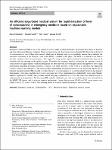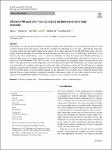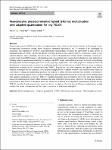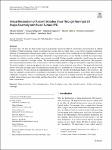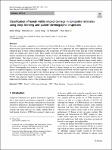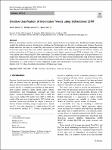Search
Author
- Jorgensen, Ed (3)
- McFadyen, Ron (3)
- Nora, El-Rashidy (3)
- Christian, Homeyer (2)
- next >
Subject
- programming (10)
- Open Access (8)
- Java (7)
- Programming (7)
- next >
Date issued
- 2020 - 2025 (293)
- 2010 - 2019 (39)
- 2000 - 2009 (2)
- 1999 - 1999 (1)
Has File(s)
- true (335)
Search Results
In this paper, we construct multi-key homomorphic and fully homomorphic encryption (resp. MKHE and MKFHE) schemes with malicious circuit privacy. Our schemes are based on learning with errors (LWE) besides appropriate circular security assumptions. In contrast, the previous maliciously circuit-private MKFHE scheme by Chongchitmate and Ostrovsky (PKC, 2017) is based on the non-standard decisional small polynomial ratio (DSPR) assumption with a super-polynomial modulus, besides ring learning with errors and circular security assumptions. We note that it was shown by Albrecht et al. (CRYPTO, 2016) that there exists a sub-exponential time attack against this type of DSPR assumption. The main building block of our maliciously circuit-private MKFHE scheme is a (plain) MKFHE scheme by Brak... |
We propose a novel end-to-end curriculum learning approach for sparsely labelled animal datasets leveraging large volumes of unlabelled data to improve supervised species detectors. We exemplify the method in detail on the task of finding great apes in camera trap footage taken in challenging real-world jungle environments. In contrast to previous semi-supervised methods, our approach adjusts learning parameters dynamically over time and gradually improves detection quality by steering training towards virtuous self-reinforcement. To achieve this, we propose integrating pseudo-labelling with curriculum learning policies and show how learning collapse can be avoided. We discuss theoretical arguments, ablations, and significant performance improvements against various state-of-the-art... |
Emergency medicine (EM) is one of the attractive research fields in which researchers investigate their efforts to diagnose and treat unforeseen illnesses or injuries. There are many tests and observations are involved in EM. Detection of the level of consciousness is one of these observations, which can be detected using several methods. Among these methods, the automatic estimation of the Glasgow coma scale (GCS) is studied in this paper. The GCS is a medical score used to describe a patient’s level of consciousness. This type of scoring system requires medical examination that may not be available with the shortage of the medical expert. Therefore, the automatic medical calculation for a patient’s level of consciousness is highly needed. |
In this paper, we study the Time-Dependent k Nearest Neighbor (TD-kNN) query on moving objects that aims to return k objects arriving at the query location with the least traveling cost departing at a given time t. Although the kNN query on moving objects has been widely studied in the scenario of the static road network, the TD-kNN query tends to be more complicated and challenging because under the time-dependent road network, the cost of each edge is measured by a cost function rather than a fixed distance value. To tackle such difficulty, we adopt the framework of GLAD and develop an advanced index structure to support efficient fastest travel cost query on time-dependent road network. In particular, we propose the Time-Dependent H2H (TD-H2H) index, which pre-computes the aggreg... |
Deep neural networks (DNNs) have delivered unprecedented achievements in the modern Internet of Everything society, encompassing autonomous driving, expert diagnosis, unmanned supermarkets, etc. It continues to be challenging for researchers and engineers to develop a high-performance neuromorphic processor for deployment in edge devices or embedded hardware. DNNs’ superpower derives from their enormous and complex network architecture, which is computation-intensive, time-consuming, and energy-heavy. Due to the limited perceptual capacity of humans, accurate processing results from DNNs require a substantial amount of computing time, making them redundant in some applications. Utilizing adaptive quantization technology to compress the DNN model with sufficient accuracy is crucial f... |
In recent years, 3D data has been widely used in archaeology and in the field of conservation and restoration of cultural properties. Virtual restoration, which reconstructs the original state in virtual space, is one of the promising applications utilizing 3D scanning data. Though many studies of virtual restoration have been conducted, it is still challenging to restore the cultural properties that consist of multiple deformable components because it is not feasible to identify the original shape uniquely. As a solution to such a problem, we proposed a non-rigid 3D shape assembly method for virtually restoring wooden ships that are composed of multiple timbers. The deformed timber can be well represented by ruled surface. We proposed a free-form deformation method with a ruled sur... |
Many current trackers utilise an appearance model to localise the target object in each frame. However, such approaches often fail when there are similar-looking distractor objects in the surrounding background, meaning that target appearance alone is insufficient for robust tracking. In contrast, humans consider the distractor objects as additional visual cues, in order to infer the position of the target. Inspired by this observation, this paper proposes a novel tracking architecture in which not only is the appearance of the tracked object, but also the appearance of the distractors detected in previous frames, taken into consideration using a form of probabilistic inference known as explaining away. |
Microbiome is closely related to many major human diseases, but it is generally analyzed by the traditional statistical methods such as principal component analysis, principal coordinate analysis, etc. These methods have shortcomings and do not consider the characteristics of the microbiome data itself (i.e., the “probability distribution” of microbiome). A new method based on probabilistic topic model was proposed to mine the information of gut microbiome in this paper, taking gut microbiome of type 2 diabetes patients and healthy subjects as an example. Firstly, different weights were assigned to different microbiome according to the degree of correlation between different microbiome and subjects. |
With the increasingly comprehensive utilisation of Carbon Fibre-Reinforced Polymers (CFRP) in modern industry, defects detection and characterisation of these materials have become very important and draw significant research attention. During the past 10 years, Artificial Intelligence (AI) technologies have been attractive in this area due to their outstanding ability in complex data analysis tasks. Most current AI-based studies on damage characterisation in this field focus on damage segmentation and depth measurement, which also faces the bottleneck of lacking adequate experimental data for model training. This paper proposes a new framework to understand the relationship between Barely Visible Impact Damage features occurring in typical CFRP laminates to their corresponding cont... |
Emotion classification can be a powerful tool to derive narratives from social media data. Traditional machine learning models that perform emotion classification on Indonesian Twitter data exist but rely on closed-source features. Recurrent neural networks can meet or exceed the performance of state-of-the-art traditional machine learning techniques using exclusively open-source data and models. Specifically, these results show that recurrent neural network variants can produce more than an 8% gain in accuracy in comparison with logistic regression and SVM techniques and a 15% gain over random forest when using FastText embeddings. |



